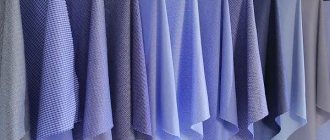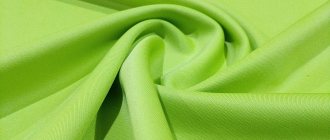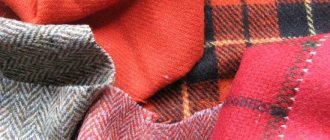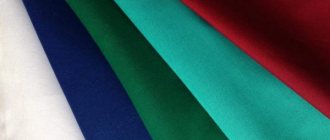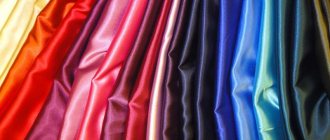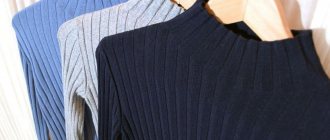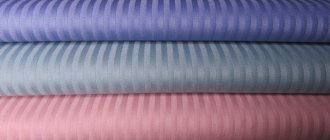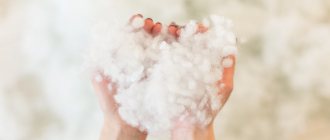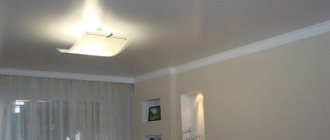A tapestry is a fabric made by cross-weaving threads with the instant creation of a plot or ornamental composition. This is a fairly high-quality material, which, due to its two- or three-layer structure, seems somewhat heavy. A large number of multi-colored threads intertwined in a special way gives rise to amazing paintings, impressive with the finest color nuances.
The history of the appearance of this fabric goes back to the reign of the ancient Egyptian pharaohs. With the development of civilization, the art of creating elegant textile designs by hand, and subsequently on looms, began to increasingly expand its horizons. The material received the name known to our contemporaries in the 17th century, when French brothers named Gobelin opened a royal manufactory for the production of decorative woven fabrics with a dense structure.
Since the emergence of tapestry art, only the appearance and design of weaving looms have changed, but the technology for producing the material itself has remained the same. In the modern process of manufacturing decorative fabric, technically more advanced equipment is used.
Composition of tapestry fabric
The jacquard weaving method is used to produce tapestries with complex multi-color patterns. The optimal color effect is achieved by weaving several warps of various shades and a standard weft, where the first type of thread plays a decisive role in creating the subject composition. The use of yarn of varying thickness contributes to the structure of the pattern.
Both natural and synthetic fibers are used to make tapestry:
- wool;
- silk;
- cotton;
- acrylic
- polyester;
- viscose.
Types of weaving threads
Wool threads are laid in short stitches, maintaining parallelism. Outwardly, they resemble horizontal rows of increased density. Stitches are distinguished by types:
- half-cross - a seam in one plane, used most often;
- continental - there are no straight lines on the back side, they are at an angle and longer than on the front side;
- straight - applied strictly up (down) or across;
- seam with grip - stitches are laid that slightly overlap the previous one, the color of the thread changes more evenly;
- wicker - a whole row overlaps the adjacent one, forming an interlacing;
- with a loop - they pull out the threads, they generally imitate the pile on the front side.
You might be interested in Description of corduroy and microcorduroy fabric: features of use
First steps
By changing the step-by-step stitching technique, the craftswoman achieves a voluminous or smooth pattern, ribbed or braided, of different densities and textures. For beginners, tapestry drawing is best to start with simple stitches.
Tapestry properties
Density
This particularly important property of the tapestry largely affects the following characteristics:
- strength;
- durability;
- wear resistance;
- creasing.
The density of the tapestry determines the scope of its application. So, for curtains, upholstery of upholstered furniture, and bedspreads, a material with an indicator ranging from 250 to 350 g/sq.m. is used. Low-density fabric is suitable for sewing clothes - only up to 180 g/sq.m.
Wrinkleability
The tapestry has good resistance to wrinkles. The fact that the fabric practically does not wrinkle is greatly facilitated by the properties of the fibers, the method of weaving and the density of the fabric.
Color fastness
This is a clear advantage of the tapestry. An important role in its manifestation is played by the qualities of synthetic threads dyed in different colors. However, fading of the fabric may occur when exposed to direct sunlight.
Shrinkage and stretching
With proper care, the tapestry does not deform in any way - it does not stretch or shrink.
When did tapestries appear in Russia?
In the 17th century, carpets appeared in Central Europe - tapestries with images woven on them. Using the method of weaving threads crosswise, a pattern was made. The founders were the Gobelin brothers, hence the name “tapestry”. Mostly manual labor was used. Weaving looms, which appeared during the heyday of manufacturing, mechanized hard work. Do-it-yourself tapestry is an art that requires the experience of an artist and painter, coupled with patience. The paints on the canvas here are replaced by multi-colored threads woven into a cross.
Vintage. Middle Ages
In Russia, they first learned about beautiful tapestries only in the 18th century under Peter 1. He was presented with a tapestry from the French nobility. In practice, it was a carpet with a pattern or skillful embroidery on canvas. At first, such works were used to decorate the apartments of Petrodvorets and other similar buildings. The tapestries featured portraits of courtiers and royalty.
Weaving masters from France helped open the first manufactory in Russia. The trellises produced there were striking in their design and complexity of execution. In the museums of St. Petersburg and Moscow, anyone can admire Russian woven carpets.
"Vintage". Middle Ages
Types of fabric
Depending on the structure, the tapestry can be:
- single layer;
- two-layer.
Density is determined by the weight of the fabric, depending on which it is divided into the following types:
- light;
- heavy;
- medium-heavy.
According to the method of implementing design and color solutions, a tapestry can be:
- with large ornaments;
- with a small pattern;
- with patterns reminiscent of embroidery;
- melange;
- plain painted.
The method of weaving the warp and weft influences the fact that tapestry fabric is defined as:
- one-sided;
- bilateral.
Application area
Thanks to its decorativeness and sophistication, as well as a host of other advantages, tapestry fabric invariably inspires designers of various directions to embody the most daring ideas. This material is used in the following areas:
- production of armchairs, sofas and other types of upholstered furniture;
- production of interior accessories (curtains, bedspreads, pillows, paintings, carpets, decorative panels);
- tailoring.
Regarding the last of these uses of tapestry, the fashion industry has firmly staked out its right to use this fabric in the creation of stunning suits, dresses, bags, cosmetic bags, belts and shoes.
Pros and cons of tapestry fabric
The versatility of tapestry is due to a number of its advantages. One of the favorite materials of decorators conveniently combines the following qualities:
- variety of shades and color fastness;
- beauty of patterns and strength;
- unique texture and durability;
- visual appeal and practicality;
- high tactile properties and functionality.
The tapestry is not without some shortcomings. These include:
- the heaviness of certain types of fabric;
- rigidity, due to which the material is practically impossible to drape.
In addition, it is not advisable to wash the tapestry at home, or iron it or subject it to other WTO methods. All this should not be done to prevent folds or creases from appearing on the fabric.
What is a tapestry: texture and composition
First of all, tapestry for upholstery is a very dense and heavy textile. This is explained by the manufacturing method: multi-layer jacquard weave, which uses a huge number of threads (it can be 10 times more than in jacquard!). In the manufacture of such fabric, threads are used in a variety of colors and shades, which allows you to create unique designs. In the most expensive tapestry it is an image of ancient paintings, in others it is floral and abstract patterns.
The tapestry has a very ancient history. Previously, its strength was ensured by the use of wool or silk. Today, synthetic fibers play the role of “strengtheners” for furniture fabrics. Modern upholstery textiles are made from fibers such as:
- silk;
- wool;
- cotton;
- viscose;
- polyester;
- acrylic;
- lurex
Even gold or silver threads are added to them, which makes it possible to produce very elegant varieties for the most discerning customers. In this case, stronger threads are used as warp, and softer and more elastic ones are used as weft. It is these threads, covering the base in the right order, that create unique patterns.
Advice
Do not use expensive and elegant tapestry fabrics to create an “average” interior. It looks tasteless, but it will make you go broke when you buy it. Here, it is better to choose more practical tapestry textiles for a sofa or armchairs.
Care instructions
As mentioned above, it is better not to wash or iron the tapestry. Despite the high degree of practicality of the material, it still needs care. To clean it, you can use a vacuum cleaner or a soft brush. If there are stains that need to be removed urgently, you should seek the services of specialists.
If you intend to place tapestry products for long-term storage, you should choose a well-ventilated place for this. To prevent folds and creases from occurring on the material, you should wrap it with the front side, for example, on a drainage pipe of as large a diameter as possible.
If there is a cat in the house that is a big fan of sharpening its claws on a dense surface, then when placing tapestry products in the interior, you need to take this fact into account.
Let's start embroidery
How to make a tapestry? To transfer the idea of a painting onto a canvas, you need to determine the application technique. The image is drawn on the base with a marker or chalk. Step-by-step transfer method:
- Secure the drawing, stretch the base on the glass. Carefully trace all the lines. If the sample is clearly visible, clear contours are obtained.
- This method will not work with a sackcloth base. A carbon copy is needed, it is applied with the ink side down, and a sample is placed on top. By tracing all the contour lines, the future plot is transferred to the base.
- As an alternative, a different technology is used - turn the sketch over and trace all the lines with a pencil marked “m”. Place the sheet with the pattern facing up on the fabric. With pressure, repeat all the lines, while the previous application will be imprinted on the fabric. The method is convenient for burlap.
- As an option, cut out the outlines of the tapestry image on cardboard. Then apply them and trace the contours.
- After completing the transfer of the main lines, it is recommended to paint with the appropriate colors. Water-based acrylic paints are suitable; they will not clog the canvas or canvas.
This may interest you Which fabric to choose instead of velvet: which material will be simpler
Transfer through glass
It is better to use tapestry weaving in a line or contour manner, vertically down through the base, then up from the left side to the right. Maintaining parallelism is a prerequisite between the stitches and the shared thread. Contour application begins with stitches around, gradually moving in a spiral towards the middle.
Customer Reviews
In general, the tapestry evokes only positive emotions among the owners of products made from it. They note the special style and expressiveness of the external component of such products. The exquisite beauty of the fabric, distinguished by multiple weaves of colored threads folded into patterns, does not go unnoticed by connoisseurs of ancient art.
Despite all the advantages, customer reviews also touch on some of the tapestry’s disadvantages. Especially with regard to the rules for caring for products made from it. At the same time, thoughts immediately come to mind about the possibility of resorting to dry cleaning services.
